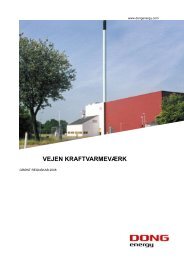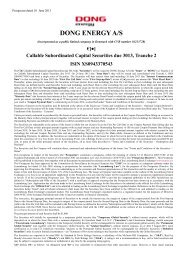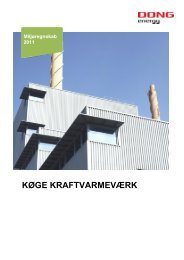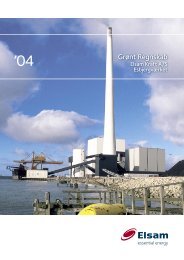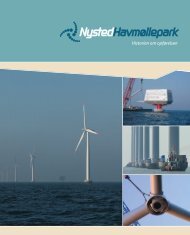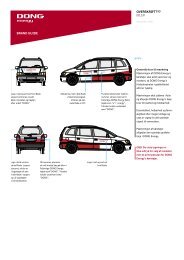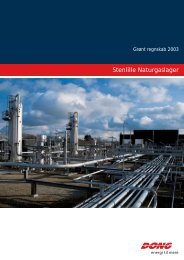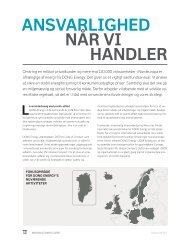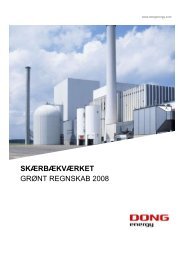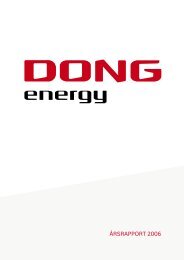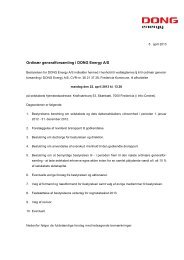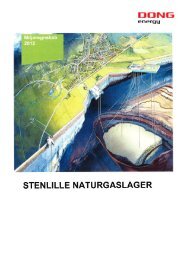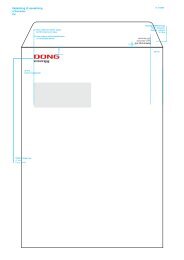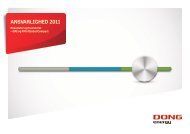ANNUAL REPORT 2011 - DONG Energy
ANNUAL REPORT 2011 - DONG Energy
ANNUAL REPORT 2011 - DONG Energy
Create successful ePaper yourself
Turn your PDF publications into a flip-book with our unique Google optimized e-Paper software.
consolIdated NON-FINANCIAL STATEMENTS<br />
Accounting policies for non-financial data<br />
General<br />
The overview of non-financial highlights for the reporting<br />
period 1 January – 31 December <strong>2011</strong> on page 6 of this<br />
report and in <strong>DONG</strong> <strong>Energy</strong>’s Group annual report and the<br />
financial review for <strong>2011</strong> on pages 35-39 of this report and<br />
in <strong>DONG</strong> <strong>Energy</strong>’s Group annual report include data from<br />
the whole of the <strong>DONG</strong> <strong>Energy</strong> Group.<br />
<strong>DONG</strong> <strong>Energy</strong>’s non-financial reporting is audited externally.<br />
Reference is made to the assurance statement on<br />
page 186 of this report and page 125 of <strong>DONG</strong> <strong>Energy</strong>’s<br />
Group annual report.<br />
The collection and determination of non-financial data<br />
comprise data relating to production, environment, health<br />
and safety and employees, applying the same delimitations<br />
and basis as for the financial data, except as otherwise<br />
described in the following sections. In practice, this means<br />
that the reporting comprises all operative operating activities<br />
in <strong>DONG</strong> <strong>Energy</strong> and the Group’s subsidiaries and<br />
jointly controlled entities.<br />
reporting and materiality criteria<br />
Management’s reasons for choosing the environmental<br />
data that are included in this report are based on the<br />
evaluations in 2007 of the business areas’ environmental<br />
impacts, the subsequently set corporate targets and the<br />
underlying key performance indicators (KPIs) identified<br />
for one or more of the business areas. Within occupational<br />
health and safety, occupational injuries and injury<br />
frequency have been chosen as the key parameters based<br />
on a management evaluation. The same applies to the employee<br />
data chosen.<br />
standards applied<br />
<strong>DONG</strong> <strong>Energy</strong> is a signatory to the UN Global Compact<br />
and prepares an annual ”Communication on Progress”<br />
report to the UN. <strong>DONG</strong> <strong>Energy</strong>’s ”Communication on<br />
Progress <strong>2011</strong>” can be found at dongenergy.com and<br />
Global Compact’s website at unglobalcompact.org/COP.<br />
<strong>DONG</strong> <strong>Energy</strong> reports annually in accordance with the<br />
Global Reporting Initiative’s (GRI) Reporting Guidelines<br />
G3.0. <strong>DONG</strong> <strong>Energy</strong> also reports in accordance with the<br />
GRI’s sector supplement for electricity producers and electricity<br />
distributors, called EUSS (Electric Utilities Sector<br />
Supplement). The reporting is in accordance with application<br />
level B+.<br />
152 COnsOliDatED nOn-finanCial statEmEnts – <strong>DONG</strong> ENERGY <strong>ANNUAL</strong> <strong>REPORT</strong> <strong>2011</strong><br />
<strong>DONG</strong> <strong>Energy</strong> has carried out an assessment of materiality<br />
of the GRI indicators based on the methodology proposed<br />
by the GRI. The methodology in its entirety has not been<br />
changed in the period 2008–<strong>2011</strong>, and appears in <strong>DONG</strong><br />
<strong>Energy</strong>’s GRI report, which can be found at www.dongenergy.com.<br />
Organisation and data quality<br />
The business areas’ reporting has been systematised and<br />
harmonised via a common reporting system that forms<br />
the basis for the consolidated reporting. The business<br />
areas are responsible for the quality of their data based on<br />
a reporting procedure designed to support a Group-wide<br />
harmonised approach to data quality. The procedure also<br />
ensures that data in the consolidated reporting can be<br />
reproduced in accordance with the stated methods for recognition<br />
and measurement and for determination of data<br />
described below. Data have been recognised in the consolidated<br />
reporting based on the data reported by the business<br />
areas and following an accounting technical analysis<br />
at Group level.<br />
additions and disposals during the year<br />
If an activity has not been owned for the entire reporting<br />
period, it is, in principle, recognised from the date on which<br />
operation began, the acquisition date or up to the date of<br />
transfer.<br />
For information on acquisitions and disposals of enterprises,<br />
reference is made to notes 28 and 29 on Acquisition<br />
of enterprises and Disposal of enterprises in this report or<br />
<strong>DONG</strong> <strong>Energy</strong>’s Group annual report.<br />
The capacity at Vejen CHP plant is registered with the<br />
Danish <strong>Energy</strong> Authority, but the plant capacity in question<br />
is not used in <strong>DONG</strong> <strong>Energy</strong>’s production unless<br />
Energinet.dk requests that it be brought back into service.<br />
Changes to performance summary<br />
compared with 2010<br />
Compared with 2010, there are two indicators that are no<br />
longer reported as non-financial key performance indicators.<br />
The indicators that have been deemed to no longer<br />
be material and/or are not comprised by corporate targets<br />
are the ”1 tonne less CO per employee” campaign and<br />
2<br />
”Percentage of CO -neutral fuels at power stations”.<br />
2<br />
A new indicator has been added to the non-financial key<br />
performance indicators, ”Green proportion of electricity<br />
and heat generation”.



